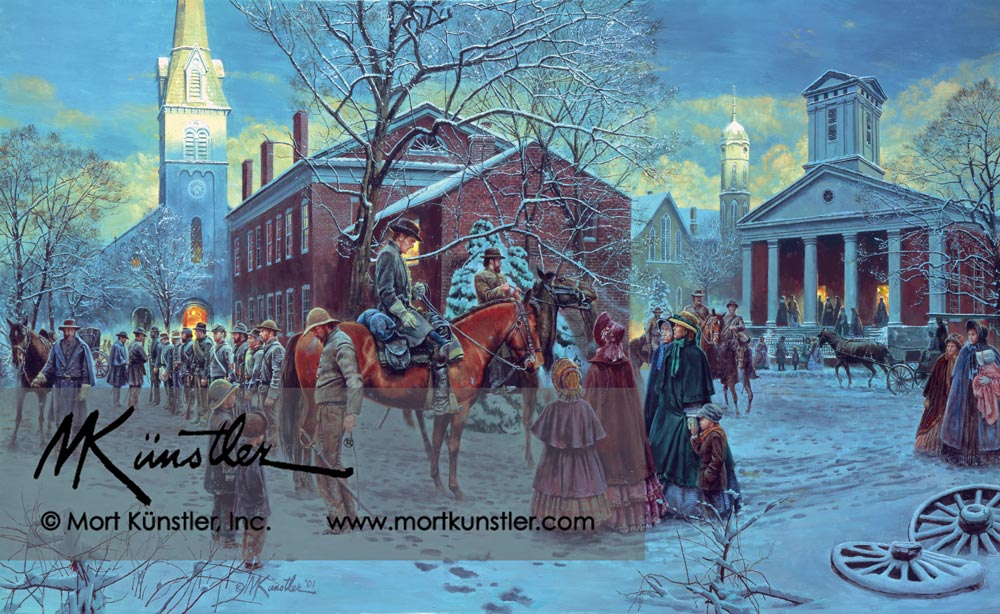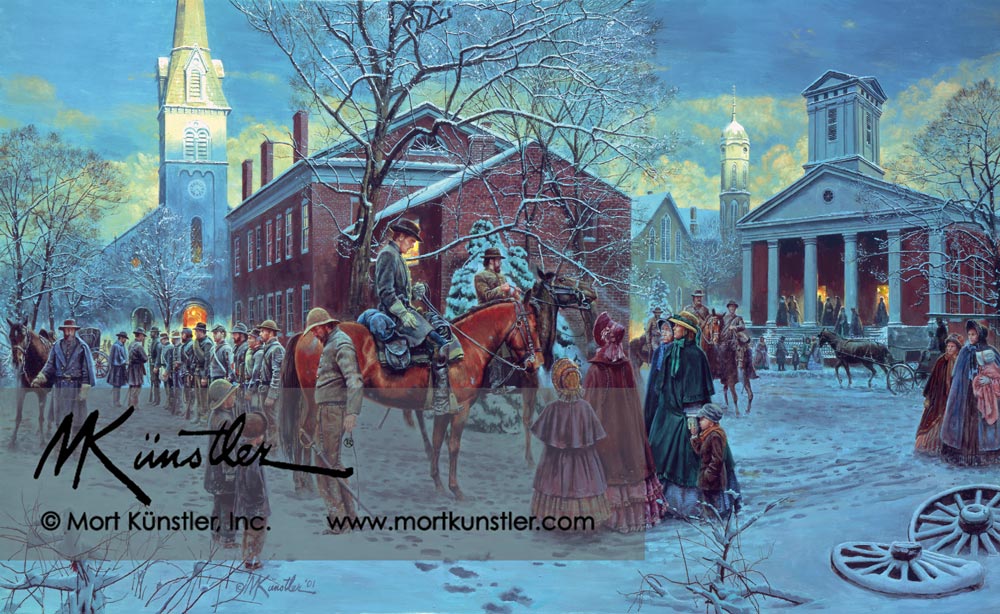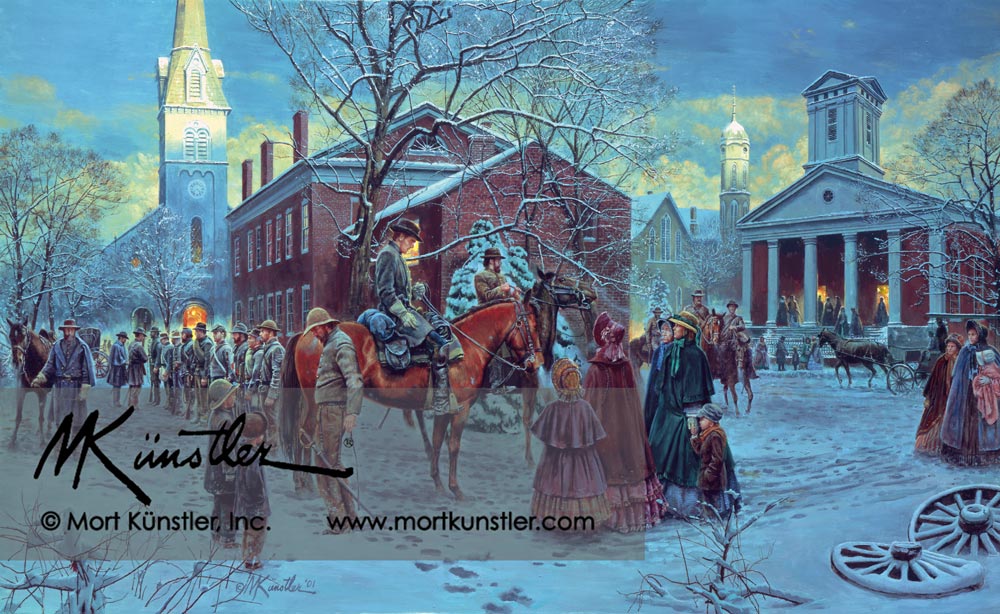The Official Mort Künstler Website
Changing of the Pickets - limited edition print
Changing of the Pickets - limited edition print
Fredericksburg, Virginia December 6, 1862
Regular price
$500.00 USD
Regular price
Sale price
$500.00 USD
Unit price
per
Tax included.
Shipping calculated at checkout.
Couldn't load pickup availability
Custom framing is available for this print. Please call 800-850-1776 or email info@mortkunstler.com for more information.
LIMITED EDITION PRINTS
Paper Prints
Reproduction technique: Fine offset lithography on neutral pH archival quality paper using the finest fade-resistant inks.
Each print is numbered and signed by the artist and accompanied by a Certificate of Authenticity.
Image Size: 17¾” x 29¼” • Overall Size: 23¾” x 34½”
Signed & Numbered • Edition Size: 1150
Signed Artist’s Proof • Edition Size: 100
Giclée Canvas Prints
Reproduction technique: Giclées are printed with the finest archival pigmented inks on canvas.
Each print is numbered and signed by the artist and accompanied by a Certificate of Authenticity.
Classic Edition 20” x 33”
Signed & Numbered • Edition Size: 200
Signed Artist’s Proof • Edition Size: 20
Historical Information
They too bore the burden of war. America’s civilians – both North and South – endured hardship and deprivation comparable, in many cases, to the men in uniform. They endured the loss of loved ones - husbands, fathers and sons - who were “gone for a soldier.” They sacrificed time and treasure to support the men at war. And in many cases, the loss of loved ones was permanent. Between 1861 and 1865, the wages of war were often issued in deep and personal suffering on the home front. This was especially true in the South, where the war fought, and it was particularly true in Fredericksburg, Virginia - a handsome, historic city perched alongside Virginia’s Rappahannock River.
As the War Between the States swept over the embattled South, it came to Fredericksburg with a mighty vengeance in December of 1862. Huge and powerful, the North’s Army of the Potomac, commanded by General Ambrose E. Burnside, massed on the northern side of the Rappahannock. On the opposite side lay General Robert E. Lee’s hard-driving, hard-fighting Army of Northern Virginia. Between both armies lay picturesque Fredericksburg. Eventually, one of the bloodiest battles of the war would ravage Fredericksburg, leaving devastation in its wake.
In early December, however - as winter draped the riverside town in its customary cloak of white - Fredericksburg’s residents made do with the ways of war. To avoid drawing Federal artillery fire into the city, General Lee kept a reduced presence in the city: even the handful of troops detailed for picket duty were careful not to provoke enemy fire. Hard times lay ahead for the people of Fredericksburg – not only in the weeks to come, but in the years that followed until the end of the war. Yet, like Southerners everywhere - and many of their Northern counterparts - the citizens of the city valiantly moved forward with life. They endured sacrifice. They persevered. They were Americans.
Mort Künstler’s Comments
I have long been fascinated with Fredericksburg, Virginia. In many ways it was the center of action for the Eastern Theater of the war. The people of Fredericksburg had to bear so much during the conflict. Like the people of Winchester, Virginia, the residents of Fredericksburg had the war literally brought to their doorsteps. Despite the hardships and danger, however, they continued with life and bore their burden with courage and hope. Fredericksburg is also such a historical and picturesque city. I last painted this city in 1997, so for all those reasons I decided to choose a scene from Fredericksburg for my year-end snow print.
My first thought was to find a historical event which placed Stonewall Jackson on the streets of Fredericksburg. I checked with Dr. James I. Robertson, Jr. – the acclaimed historian and biographer of Stonewall Jackson – and was surprised to learn that although Jackson was at the battle of Fredericksburg, he was never actually within 3 1/2 miles of the city at any time. So I had to abandon that idea.
Finally, I decided that this painting should be devoted to the common citizens of Fredericksburg, who represented in many ways Southerners everywhere during the war - as well as their Northern counterparts. All Americans made sacrifices during that terrible conflict and I believe that all of them displayed heroic behavior. Despite all the hardships of war, they courageously continued with life. So, the people of Fredericksburg came to symbolize the American spirit of courage, sacrifice and hope.
To convey this theme, I chose an ordinary event – the changing of the Confederate picket guard in Fredericksburg. Twice I’ve featured St. George’s Episcopal Church in Fredericksburg. I wanted to do so again, but this time I wanted to include The Presbyterian Church, which had such a handsome and historical structure during the war. Using old maps, under the direction of National Park Service historians Noel Harrison and Frank O’Reilly – and with consultation by Sue Henderson of the Historic Fredericksburg Foundation, I was able to determine the viewpoint that accurately incorporated The Presbyterian Church and St. George’s Episcopal Church, as well as the Fredericksburg Courthouse. I was also able to obtain additional local data that helped me reconstruct the scene accurately. This reconstruction was challenging because the scene, as depicted in the painting, cannot be seen today: The view is partially blocked today by an ATM site for the National Bank of Fredericksburg. The bank's historical building, which is in the center of the painting, has changed little from Civil War days. The smaller building in the center foreground was the bank kitchen. It was moved to Princess Anne Street and houses the Nationwide Insurance offices today.
Dr. Robertson supplied information on weather conditions from his extensive research, and I learned that sunset in Fredericksburg on December 6th occurred at 4:52 p.m. The townspeople are seen gathering at the churches for evening services. The two young boys admire the couriers who are getting ready to deliver dispatches to various army commands posted to Marye’s Heights. A group of young women inquire about the situation. As darkness descends, the pickets undergoing inspection soon will be on their way to relieve the picket line on duty near the river – and the women and children of Fredericksburg, encouraged by their evening worship services, will return home to resume their lives in the seat of the war.
View full details
LIMITED EDITION PRINTS
Paper Prints
Reproduction technique: Fine offset lithography on neutral pH archival quality paper using the finest fade-resistant inks.
Each print is numbered and signed by the artist and accompanied by a Certificate of Authenticity.
Image Size: 17¾” x 29¼” • Overall Size: 23¾” x 34½”
Signed & Numbered • Edition Size: 1150
Signed Artist’s Proof • Edition Size: 100
Giclée Canvas Prints
Reproduction technique: Giclées are printed with the finest archival pigmented inks on canvas.
Each print is numbered and signed by the artist and accompanied by a Certificate of Authenticity.
Classic Edition 20” x 33”
Signed & Numbered • Edition Size: 200
Signed Artist’s Proof • Edition Size: 20
Historical Information
They too bore the burden of war. America’s civilians – both North and South – endured hardship and deprivation comparable, in many cases, to the men in uniform. They endured the loss of loved ones - husbands, fathers and sons - who were “gone for a soldier.” They sacrificed time and treasure to support the men at war. And in many cases, the loss of loved ones was permanent. Between 1861 and 1865, the wages of war were often issued in deep and personal suffering on the home front. This was especially true in the South, where the war fought, and it was particularly true in Fredericksburg, Virginia - a handsome, historic city perched alongside Virginia’s Rappahannock River.
As the War Between the States swept over the embattled South, it came to Fredericksburg with a mighty vengeance in December of 1862. Huge and powerful, the North’s Army of the Potomac, commanded by General Ambrose E. Burnside, massed on the northern side of the Rappahannock. On the opposite side lay General Robert E. Lee’s hard-driving, hard-fighting Army of Northern Virginia. Between both armies lay picturesque Fredericksburg. Eventually, one of the bloodiest battles of the war would ravage Fredericksburg, leaving devastation in its wake.
In early December, however - as winter draped the riverside town in its customary cloak of white - Fredericksburg’s residents made do with the ways of war. To avoid drawing Federal artillery fire into the city, General Lee kept a reduced presence in the city: even the handful of troops detailed for picket duty were careful not to provoke enemy fire. Hard times lay ahead for the people of Fredericksburg – not only in the weeks to come, but in the years that followed until the end of the war. Yet, like Southerners everywhere - and many of their Northern counterparts - the citizens of the city valiantly moved forward with life. They endured sacrifice. They persevered. They were Americans.
Mort Künstler’s Comments
I have long been fascinated with Fredericksburg, Virginia. In many ways it was the center of action for the Eastern Theater of the war. The people of Fredericksburg had to bear so much during the conflict. Like the people of Winchester, Virginia, the residents of Fredericksburg had the war literally brought to their doorsteps. Despite the hardships and danger, however, they continued with life and bore their burden with courage and hope. Fredericksburg is also such a historical and picturesque city. I last painted this city in 1997, so for all those reasons I decided to choose a scene from Fredericksburg for my year-end snow print.
My first thought was to find a historical event which placed Stonewall Jackson on the streets of Fredericksburg. I checked with Dr. James I. Robertson, Jr. – the acclaimed historian and biographer of Stonewall Jackson – and was surprised to learn that although Jackson was at the battle of Fredericksburg, he was never actually within 3 1/2 miles of the city at any time. So I had to abandon that idea.
Finally, I decided that this painting should be devoted to the common citizens of Fredericksburg, who represented in many ways Southerners everywhere during the war - as well as their Northern counterparts. All Americans made sacrifices during that terrible conflict and I believe that all of them displayed heroic behavior. Despite all the hardships of war, they courageously continued with life. So, the people of Fredericksburg came to symbolize the American spirit of courage, sacrifice and hope.
To convey this theme, I chose an ordinary event – the changing of the Confederate picket guard in Fredericksburg. Twice I’ve featured St. George’s Episcopal Church in Fredericksburg. I wanted to do so again, but this time I wanted to include The Presbyterian Church, which had such a handsome and historical structure during the war. Using old maps, under the direction of National Park Service historians Noel Harrison and Frank O’Reilly – and with consultation by Sue Henderson of the Historic Fredericksburg Foundation, I was able to determine the viewpoint that accurately incorporated The Presbyterian Church and St. George’s Episcopal Church, as well as the Fredericksburg Courthouse. I was also able to obtain additional local data that helped me reconstruct the scene accurately. This reconstruction was challenging because the scene, as depicted in the painting, cannot be seen today: The view is partially blocked today by an ATM site for the National Bank of Fredericksburg. The bank's historical building, which is in the center of the painting, has changed little from Civil War days. The smaller building in the center foreground was the bank kitchen. It was moved to Princess Anne Street and houses the Nationwide Insurance offices today.
Dr. Robertson supplied information on weather conditions from his extensive research, and I learned that sunset in Fredericksburg on December 6th occurred at 4:52 p.m. The townspeople are seen gathering at the churches for evening services. The two young boys admire the couriers who are getting ready to deliver dispatches to various army commands posted to Marye’s Heights. A group of young women inquire about the situation. As darkness descends, the pickets undergoing inspection soon will be on their way to relieve the picket line on duty near the river – and the women and children of Fredericksburg, encouraged by their evening worship services, will return home to resume their lives in the seat of the war.





